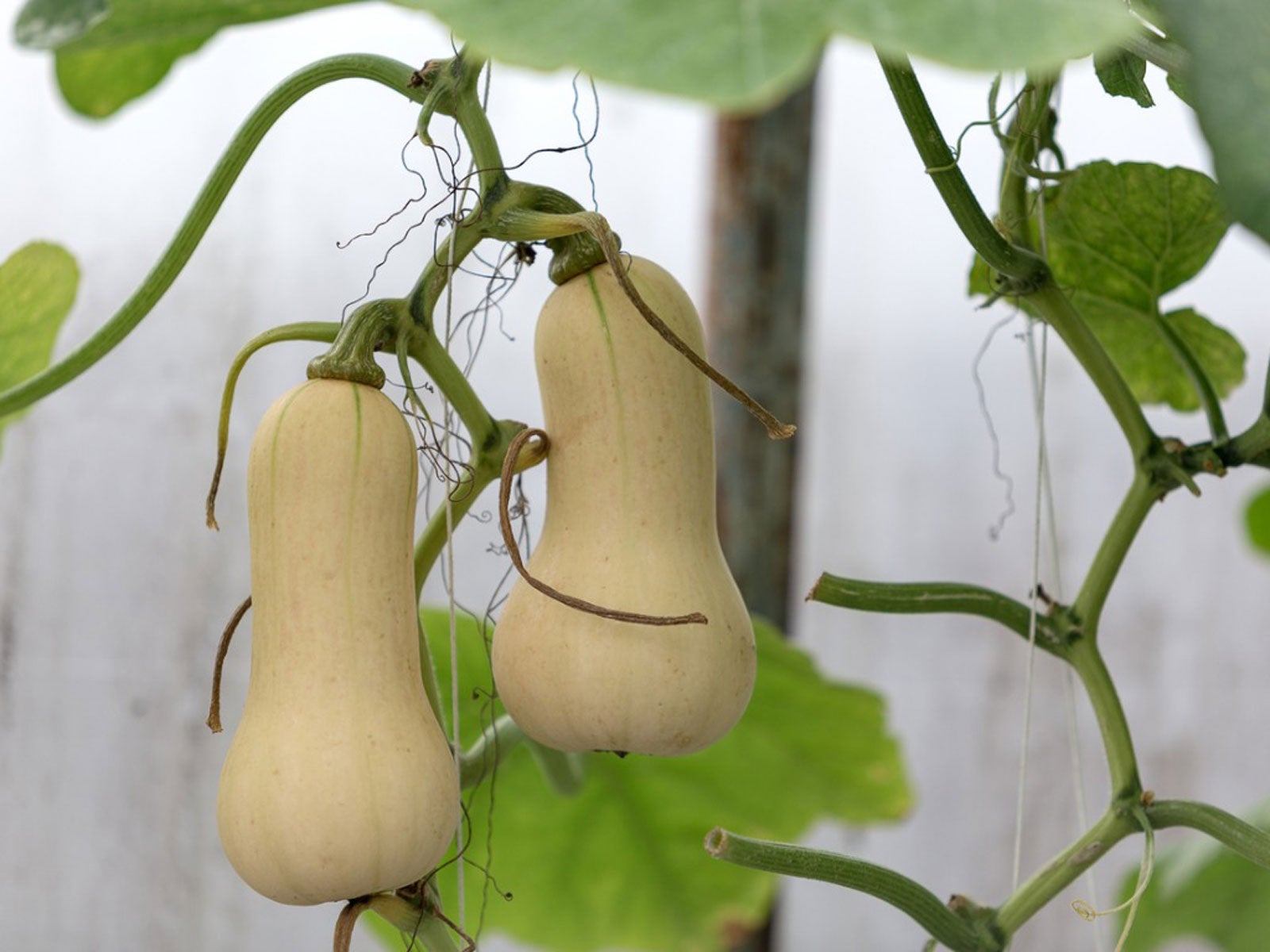To grow butternut squash, plant seeds in warm, well-drained soil with full sun exposure. Water regularly and provide ample space for vines to spread.
Butternut squash is a popular and nutritious winter squash, known for its sweet, nutty flavor and versatility in cooking. It thrives in warm climates and requires a long growing season, typically around 110-120 days. Start by choosing a sunny location with rich, well-draining soil.
Plant seeds directly into the ground after the last frost date, spacing them about 3 to 4 feet apart to accommodate the sprawling vines. Consistent watering is crucial, especially during dry periods, to ensure healthy growth. With proper care, you can enjoy a bountiful harvest of delicious butternut squash.

Credit: askthefoodgeek.com
Choosing The Right Variety
Choosing the right variety of butternut squash is crucial for a successful harvest. Different varieties thrive in specific climates and offer unique flavors and textures. Understanding these differences helps you select the best type for your garden.
Popular Varieties
| Variety | Description | Days to Maturity |
|---|---|---|
| Waltham | Classic, sweet flavor. Large, tan fruits. | 85-100 |
| Butterbush | Compact plant, good for small spaces. | 75-80 |
| Early Butternut | Fast-growing, smaller fruits. Early harvest. | 75-80 |
| Honeynut | Small, sweet, and rich in flavor. | 100-110 |
Climate Considerations
Butternut squash requires warm weather to grow well. Choose a variety that suits your local climate.
In cooler regions, opt for fast-growing varieties like Early Butternut. These mature quickly and can handle shorter growing seasons. For warmer areas, varieties like Waltham or Honeynut are ideal. They thrive in long, hot summers.
Make sure to check the frost dates in your area. Plant after the last frost to ensure your squash grows well.
Preparing The Soil
Preparing the soil is crucial for growing healthy butternut squash. The right soil type and proper nutrients help your plants thrive. This section will guide you through the soil preparation process.
Soil Type
Butternut squash prefers well-drained, sandy loam soil. This type of soil provides excellent drainage and root aeration. If your soil is heavy clay, mix in organic matter to improve texture.
Test your soil’s pH level. Butternut squash grows best in a pH range of 6.0 to 6.8. Use a soil testing kit to check the pH. Adjust the pH if needed using lime or sulfur.
| Soil Type | Characteristics |
|---|---|
| Sandy Loam | Well-drained, light, and airy |
| Clay | Heavy, poor drainage |
Nutrient Requirements
Butternut squash needs rich, fertile soil. Before planting, add compost or well-rotted manure to the soil. This boosts organic content and nutrients.
Use a balanced fertilizer, such as 10-10-10, for even nutrient distribution. Apply fertilizer at the planting time and again mid-season.
- Nitrogen (N): Promotes leafy growth.
- Phosphorus (P): Encourages root development.
- Potassium (K): Enhances fruit production and disease resistance.
Monitor your plants for signs of nutrient deficiency. Yellowing leaves may indicate a nitrogen shortage. Poor fruit development could mean a lack of phosphorus or potassium.
Planting Techniques
Growing butternut squash can be a rewarding experience. Knowing the right planting techniques is key. This guide will cover two main areas: Seed Starting and Transplanting. Follow these steps to ensure a healthy and bountiful harvest.
Seed Starting
Starting seeds indoors can give your squash a head start. Begin about four weeks before the last frost date.
- Use small pots filled with seed-starting mix.
- Plant seeds 1 inch deep.
- Water well and keep the soil moist.
- Place pots in a warm spot with plenty of light.
Seedlings should appear in 7-10 days. Once they have two sets of leaves, they are ready for transplanting.
Transplanting
Transplanting seedlings is an important step. Ensure the soil is warm and all danger of frost has passed.
- Choose a sunny location with rich, well-drained soil.
- Space plants about 3 feet apart.
- Dig holes large enough for the root ball.
- Place seedlings in the holes and fill with soil.
- Water thoroughly to settle the soil.
Keep the soil moist but not waterlogged. Mulching around the plants helps retain moisture and control weeds.
| Step | Description |
|---|---|
| Seed Starting | Start indoors 4 weeks before the last frost. |
| Transplanting | Transplant seedlings after the last frost. |
Following these planting techniques will give your butternut squash the best start. Happy gardening!
Watering Guidelines
Proper watering is essential for healthy butternut squash growth. This section will cover watering frequency and the benefits of mulching. Follow these guidelines to ensure your plants thrive.
Watering Frequency
Butternut squash needs consistent moisture. Water your plants at least once a week. Increase to twice a week during hot, dry spells. Check the soil regularly. The top inch should be moist.
Use a soaker hose or drip irrigation. These methods deliver water directly to the roots. Avoid wetting the leaves to reduce disease risk.
| Condition | Watering Frequency |
|---|---|
| Normal Weather | Once a week |
| Hot/Dry Weather | Twice a week |
Mulching Benefits
Mulching helps retain soil moisture. It also keeps the soil temperature stable. Organic mulch, like straw or grass clippings, is best.
Apply a 2-3 inch layer around your plants. Keep mulch away from the stems to prevent rot.
- Retains soil moisture
- Regulates soil temperature
- Reduces weed growth
Mulching can also improve soil fertility. As the mulch breaks down, it adds nutrients to the soil.
Fertilization Tips
Fertilizing your butternut squash plants is crucial for a bountiful harvest. Proper fertilization ensures robust growth and abundant fruit production. Here are some essential tips for fertilizing your butternut squash.
Organic Options
Choosing organic fertilizers is a great way to nourish your butternut squash. These options are environmentally friendly and effective. Here are some excellent organic choices:
- Compost: Rich in nutrients, compost improves soil structure.
- Manure: Aged manure provides essential nutrients and enhances soil health.
- Fish Emulsion: This liquid fertilizer offers quick nutrient absorption.
- Bone Meal: High in phosphorus, it promotes root and flower growth.
Timing And Dosage
Applying fertilizers at the right time and in the correct amounts is essential. Follow these simple guidelines:
- Before Planting: Mix 2-3 inches of compost into the soil.
- At Planting: Use a balanced fertilizer with equal parts N-P-K.
- During Growth: Side-dress with compost or organic fertilizer every 4-6 weeks.
| Fertilizer | Application Time | Dosage |
|---|---|---|
| Compost | Before planting | 2-3 inches |
| Balanced Fertilizer | At planting | Follow package instructions |
| Organic Fertilizer | During growth | Every 4-6 weeks |
Ensure you water the plants well after fertilization. This helps the nutrients reach the roots effectively. Happy planting!

Credit: www.gardeningknowhow.com
Pest And Disease Control
Growing butternut squash can be rewarding, but pests and diseases can ruin your harvest. Implementing effective control measures helps ensure healthy plants and a bountiful yield.
Common Pests
Several pests can harm butternut squash plants. Here are the most common:
- Squash Bugs: These bugs suck sap from leaves, causing them to wilt.
- Squash Vine Borers: These pests bore into stems, causing wilting and death.
- Aphids: Small insects that suck sap and spread diseases.
- Cucumber Beetles: These beetles chew on leaves and flowers.
Preventative Measures
Preventing pests and diseases is key to growing healthy butternut squash. Use the following methods:
- Crop Rotation: Rotate crops each year to prevent pests and diseases.
- Companion Planting: Plant marigolds or nasturtiums to repel pests.
- Neem Oil: Spray neem oil to deter many pests.
- Handpicking: Regularly inspect plants and remove visible pests by hand.
Use these control measures to protect your butternut squash plants. Healthy plants produce a better harvest.
Harvesting Tips
When it comes to growing butternut squash, knowing how to harvest correctly is crucial. Harvesting at the right time ensures you get the best flavor and longest storage life. Below are some essential tips and methods for harvesting butternut squash effectively.
Harvest Timing
Timing your harvest is key for the best results. Butternut squash is ready when the skin turns a deep, solid tan. Use your fingernail to test; if the skin resists puncture, it’s ready. Always use a sharp knife or pruners to cut the squash from the vine. Leave about two inches of stem attached to the fruit. This helps in preventing rot during storage.
Storage Methods
Proper storage is essential to keep your butternut squash fresh for months. After harvesting, let the squash cure in a warm, dry place for about 10 days. Ideal curing temperature is between 80-85°F. Once cured, store them in a cool, dry area. The perfect storage temperature is around 50-55°F.
- Keep squash off the ground using wooden pallets or shelves.
- Avoid stacking to prevent bruising and pressure damage.
- Check stored squash regularly for any signs of spoilage.
Following these tips ensures your butternut squash stays fresh and delicious for months.
:max_bytes(150000):strip_icc()/butternutcrop-06310b117b0043ddaad037554198f649.jpg)
Credit: www.treehugger.com
Companion Planting
Companion planting helps butternut squash grow better. It uses good plant neighbors. These plants help each other. They keep bugs away and help the soil. Here are some tips for companion planting.
Beneficial Plants
Some plants help butternut squash grow strong. They offer many benefits.
- Beans: Beans give nitrogen to the soil. This helps butternut squash grow.
- Radishes: Radishes keep away squash bugs and beetles.
- Nasturtiums: Nasturtiums repel pests like aphids. They also attract good bugs like bees.
- Marigolds: Marigolds keep away harmful nematodes. They also attract pollinators.
- Corn: Corn gives butternut squash some shade. This helps in hot weather.
Plants To Avoid
Some plants do not get along with butternut squash. They can hurt growth.
- Potatoes: Potatoes and butternut squash compete for nutrients. This weakens both plants.
- Onions: Onions release chemicals that can stunt squash growth.
- Garlic: Garlic can also release chemicals that harm squash.
- Tomatoes: Tomatoes and squash both need a lot of nutrients. This can cause a nutrient shortage.
Using these tips, you can grow healthy butternut squash. Happy planting!
Frequently Asked Questions
How To Plant Butternut Squash Seeds?
Plant butternut squash seeds directly in warm soil after the last frost. Space them 3-4 feet apart. Ensure full sunlight.
When To Harvest Butternut Squash?
Harvest butternut squash when the skin is hard and tan. This usually occurs in late summer or early fall.
How Much Water Does Butternut Squash Need?
Water butternut squash deeply once a week. Ensure the soil remains consistently moist, not waterlogged.
What Type Of Soil Is Best For Butternut Squash?
Butternut squash thrives in well-drained, fertile soil. Enrich the soil with compost for best results.
Conclusion
Growing butternut squash can be rewarding and fun. Follow these steps for a bountiful harvest. Start with quality seeds. Ensure proper soil and sunlight. Regular watering and pest control are crucial. Enjoy delicious, home-grown butternut squash. Happy gardening!
